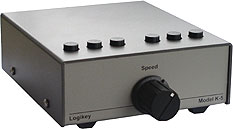The Perfect Keyer

The Perfect Keyer.
What would make the perfect stand-alone CW keyer?
It would be extremely easy to send perfect code with – intuitive – super friendly timing characteristics – perfectly mated to the paddle so that you don’t have to think – just let the CW effortlessly roll off your fingers.
If desired, it would be able to match the timing logic of whatever keyer design you are comfortable with, such as Curtis “A” timing, or the Accukeyer, and have switchable dot and dash memory. And be fully iambic of course. It would have autospacing available, but switched on only if you wanted it.
The speed range would be customizable, so you could set any range you wanted within a limit of 5 – 60 words per minute. And the speed control range would be perfectly linear. The keyer would offer precise speed read-out in words per minute. The monitor tone would be customizable too. And naturally it would have adjustable weighting.
It would have memories. Lots of memories, so you could set up sets of messages for other operators in your family, or sets for different contests. And the messages would be non-volatile, so they wouldn’t be trashed if you lost power or some back-up battery expires.
For contests it would have automatic serial numbers – and an easy way to back off a number in case of a dupe. Entering messages into memory should be easy, instead of a frantic loading sequence, and play back perfectly timed. And, you’d like to be able to edit a message when you make a mistake near the end of loading it, so you could correct it without having to send the entire message again.
Contest messages could be programmed with variable speeds, so you could send repetitive parts of the exchange at higher speed and cut down QSO times. You’d want messages that loop, with pauses in between for CQ’ing on a dead band. You might even want a beacon capability with periods of key down time. You’d like to be able to call one message from within another. And have pauses where you could insert hand-sent CW – and even have the message automatically resume when you finish hand sending. And the messages would be non-volatile – when the power goes off they would all be saved automatically, especially for Field Day!
You might want to try high-speed meteor scatter work, so you would like a burst mode ultra speed message capability available, with blazing speeds up to 990 words per minute.
You’d certainly want full support for QSK at any speed, with variable compensation for QSK timing losses, whether running barefoot or with your linear.
You’d like the keyer to be small, reliable, a proven design, and not cost an arm and a leg. You would like it to be easy to learn and intuitive to use. And NOT a jungle of knobs, buttons and lights for a front panel. Keep it simple!
Well, guess what? If those specs sound pretty good to you, you are going to be delighted to know that such a keyer is already available – in your choice of a Complete Kit, Partial Kit, or Fully Assembled & Tested.
Logikey K-5 Keyer – Assembled & Tested
Logikit CMOS 4 Keyer – Complete Kit or Assembled & Tested
Super CMOS 3 Keyer – Partial Kit




 Webmaster NØUN
Webmaster NØUN